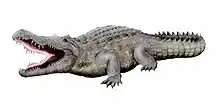| Procaimanoidea Temporal range: Eocene, | |
|---|---|
 | |
| Fossil specimen of P. utahensis | |
| Scientific classification | |
| Domain: | Eukaryota |
| Kingdom: | Animalia |
| Phylum: | Chordata |
| Class: | Reptilia |
| Clade: | Archosauromorpha |
| Clade: | Archosauriformes |
| Order: | Crocodilia |
| Family: | Alligatoridae |
| Subfamily: | Alligatorinae |
| Genus: | †Procaimanoidea Gilmore, 1946 |
| Species | |
| |
Procaimanoidea ("Before Caiman-forms") is an extinct genus of alligatorid from the Eocene of North America. It was named posthumously in 1946 by Charles W. Gilmore; the type species is P. utahensis, from the Uintan (middle Eocene) of Utah. It is based on USNM 15996, a nearly complete skull and partial left hind leg.[2] A second species, P. kayi, was named in 1941 by C.C. Mook as a species of Hassiacosuchus, for remains from the Bridgerian (early Eocene) of Wyoming.[3] It was reassigned to Procaimanoidea in 1967 by Wassersug and Hecht.[4]
Description
Procaimanoidea was a small alligatorid, and slightly heterodont, the last four teeth on each side of the jaws having blunt tips.[2]
Phylogeny
Recent studies have consistently resolved Procaimanoidea as a member of Alligatorinae, although its relative placement is disputed, as shown by the cladograms below.[5][6][7]
Cladogram from 2018 Bona et al. study:[5]
| Alligatorinae |
| ||||||||||||||||||||||||||||||||||||||||||||||||||||||||||||||||||||||||
Cladogram from 2019 Massonne et al. study:[6]
| Alligatorinae |
| |||||||||||||||||||||||||||||||||||||||||||||||||||||||||||||||||||||||||||
Cladogram from 2020 Cossette & Brochu study:[7]
| Alligatorinae |
| ||||||||||||||||||||||||||||||||||||||||||||||||||||||||||||||||||||||||
References
- ↑ Rio, Jonathan P.; Mannion, Philip D. (6 September 2021). "Phylogenetic analysis of a new morphological dataset elucidates the evolutionary history of Crocodylia and resolves the long-standing gharial problem". PeerJ. 9: e12094. doi:10.7717/peerj.12094. PMC 8428266. PMID 34567843.
- 1 2 Gilmore, Charles W. "A new crocodilian from the Eocene of Utah". Journal of Paleontology. 20 (1): 62–67.
- ↑ Mook, C.C. (1941). "A new crocodilian, Hassiacosuchus kayi, from the Bridger Eocene beds of Wyoming". Annals of the Carnegie Museum. 28: 207–220. doi:10.5962/p.330789. S2CID 251510549.
- ↑ Wassersug, R.J.; Hecht, M.K. (1967). "The status of the crocodylid genera Procaimanoidea and Hassiacosuchus in the New World". Herpetologica. 23 (1): 30–34.
- 1 2 Paula Bona; Martín D. Ezcurra; Francisco Barrios; María V. Fernandez Blanco (2018). "A new Palaeocene crocodylian from southern Argentina sheds light on the early history of caimanines". Proceedings of the Royal Society B: Biological Sciences. 285 (1885): 20180843. doi:10.1098/rspb.2018.0843. PMC 6125902. PMID 30135152.
- 1 2 Tobias Massonne; Davit Vasilyan; Márton Rabi; Madelaine Böhme (2019). "A new alligatoroid from the Eocene of Vietnam highlights an extinct Asian clade independent from extant Alligator sinensis". PeerJ. 7: e7562. doi:10.7717/peerj.7562. PMC 6839522. PMID 31720094.
- 1 2 Adam P. Cossette; Christopher A. Brochu (2020). "A systematic review of the giant alligatoroid Deinosuchus from the Campanian of North America and its implications for the relationships at the root of Crocodylia". Journal of Vertebrate Paleontology. 40: e1767638. Bibcode:2020JVPal..40E7638C. doi:10.1080/02724634.2020.1767638.
External links


